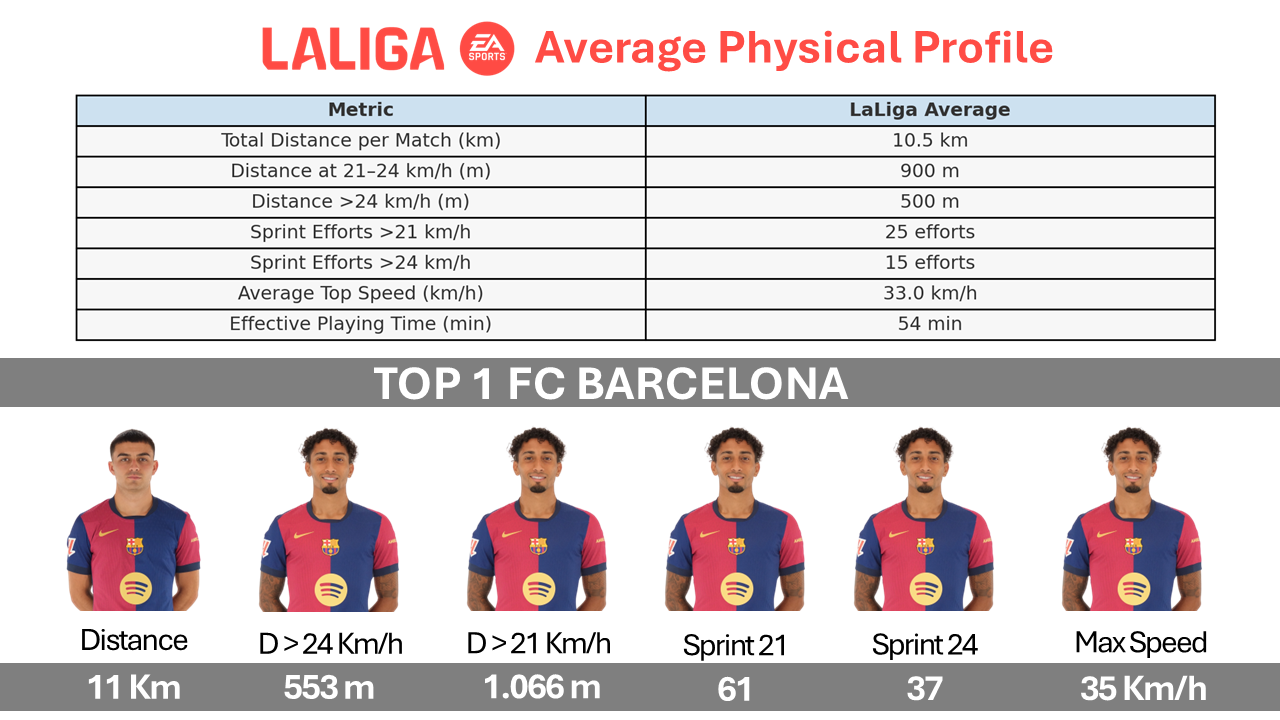
13 May Context is Everything: The Mistake of Training Without Knowing Where You Are
Why understanding your competition’s physical profile is essential to build better teams
The context shapes the demand: a LaLiga case study
A player with the same physical capabilities will not perform the same way in the Premier League, Bundesliga, or LaLiga EA Sports. Why? Because each league has its own identity—its own pace, style, and tactical culture—that shapes the type of physical performance required to succeed. As a coach, ignoring that context means training blind.
At LaLiga’s Football Intelligence department, we’ve spent years studying the physical demands of our competition. We’ve analyzed tens of thousands of match records to define a precise, data-driven picture of the “average” LaLiga player. Not a theoretical one, but a scientifically validated one (https://doi.org/10.3390/jfmk10010027).
The physical profile of a LaLiga player: what the data actually says
Based on real match performance, here are the physical benchmarks for players in LaLiga:
- Total distance: 10,000–11,000 m per match
- High-intensity distance (21–24 km/h): 800–1000 m
- Very high intensity (>24 km/h): 400–600 m
- Sprint efforts (>21 km/h): 20–30 actions per match
- Sprint efforts >24 km/h: 10–20 actions
- High Metabolic Load Distance (HMLD): 1500–1800 m (https://doi.org/10.7717/peerj.13318)
- Average top speed: 32–34 km/h (https://doi.org/10.5114/biolsport.2025.150035)
This is your reference point. But to improve your team’s physical output, you must go further.
Step 2: Analyze your team within that competition
The average league profile only tells part of the story. Next, you need to understand how your own team fits into that context. And that depends on several key factors:
- Playing style
- Ball possession percentage
- Match context (scoreline, home/away, opponent)
For instance, teams with more possession often cover less high-speed distance, but that doesn’t mean they perform fewer explosive actions (https://doi.org/10.1080/02701367.2022.2072798). Meanwhile, teams relying on direct play or transitions show greater sprint and HMLD volumes (https://doi.org/10.5114/biolsport.2024.132993).
The scoreline also shifts behavior:
- Winning teams: defenders run more off the ball, attackers less.
- Losing teams: attackers sprint more to recover or press (https://doi.org/10.3390/s21206843).
Don’t overlook the impact of effective playing time either—it significantly affects physical totals (https://doi.org/10.5114/biolsport.2024.133667).
Case Study: FC Barcelona as an example of contextual analysis within LaLiga EA Sports
To illustrate how this analysis can be applied in real life, let’s look at the aggregated data for FC Barcelona in the 2024/25 season:
- Total distance per match: ~118,000 meters (above the league average of 110,000–115,000 m)
- Distance at 21–24 km/h: ~3,943 m
- Distance >24 km/h: ~3,164 m
- Total sprint efforts >21 km/h: 487.5 per match
- Sprints >24 km/h: 230.2 per match
- Average top speed: 33.5 km/h
- Effective playing time: 57.8 minutes (above the league average of ~53–55 min)
These figures show a team that doesn’t just run a lot, but runs smart: high explosive effort volume within a model built on possession, positional control, and tactical structure. The high frequency of short sprints, coupled with longer effective play time, reflects a system based on high pressing, controlled transitions, and territorial dominance.
FC Barcelona illustrates the core message: understanding your competition is the first step, but understanding your team’s specific role within that context is what drives performance. It allows you to tailor training loads, adapt player roles, and recruit based on what your game model truly needs.
This type of analysis isn’t reserved for Big Data labs. It’s about knowing what to look for and how to interpret it—one of the most effective ways to reduce uncertainty in elite training and performance.
Step 3: Adapt for each individual player
Individualization is key. Not every player performs—or should perform—the same way. Several personal variables affect physical output:
- Position: Fullbacks and wingers lead in sprinting and high-speed actions; center backs focus on positioning (https://doi.org/10.7717/peerj.13318)
- Age: Physical capacity declines progressively after 30, especially in sprint and high-intensity running (https://doi.org/10.5114/biolsport.2023.124844)
- Genetics and muscle profile: Even ACTN3 gene variations can influence sprinting potential and injury risk (https://doi.org/10.3390/genes15030386)
Conclusion: don’t train in the dark
Training without knowing your competition’s physical profile is like preparing for a race without knowing the terrain. Average values are useful, but insufficient. You need to know how your team fits into the competition’s demands—and how each player fits within your team.
Elite football isn’t just about talent. It’s about context, strategy, and science. At LaLiga, we are committed to putting that science in the hands of the professionals who need it most: coaches.


